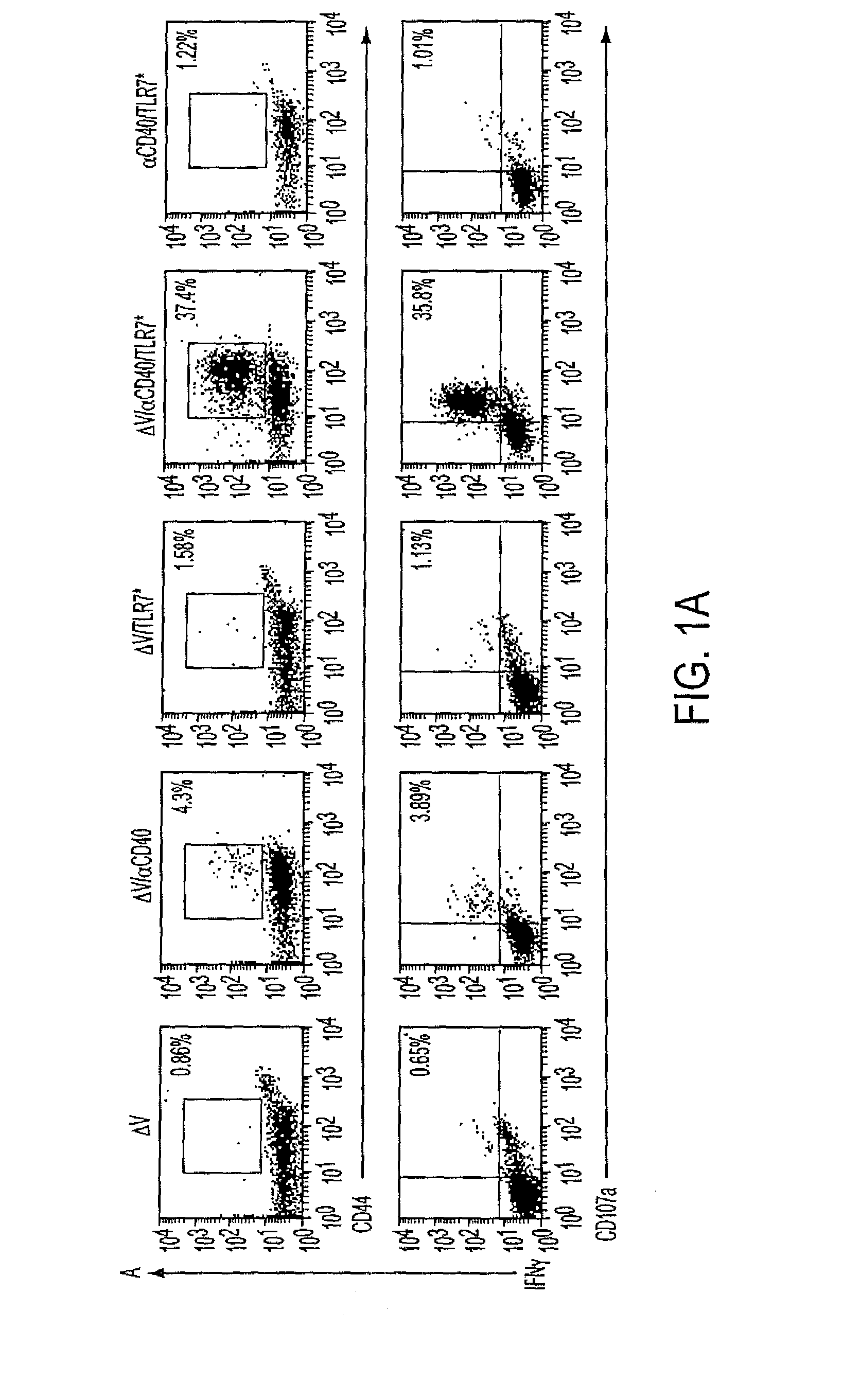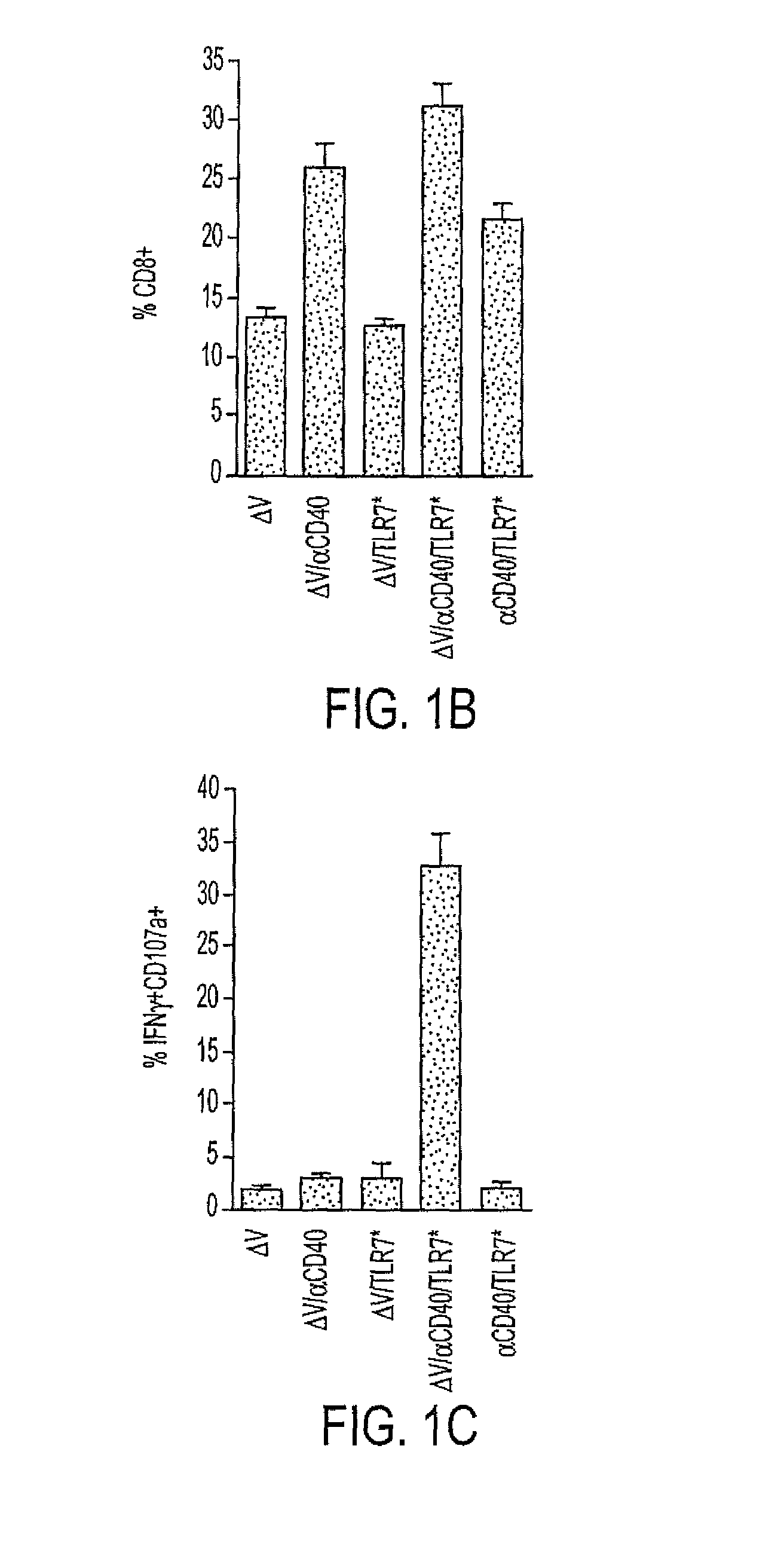Use of tlr agonists and/or type 1 interferons to alleviate toxicity of tnf-r agonist therapeutic regimens
a technology of tnfr agonist and type 1 interferon, which is applied in the direction of drug composition, plant/algae/fungi/lichens ingredients, immune-boosting effects of cd40 agonist alone, etc., can solve the problems of inapplicability in a wide range of tumors, inability to elicit robust, long-lasting immunity, and inability to achieve long-lasting immunity, so as to enhance the efficacy of target cells and not app
- Summary
- Abstract
- Description
- Claims
- Application Information
AI Technical Summary
Benefits of technology
Problems solved by technology
Method used
Image
Examples
example 1
[0162]High Frequencies of Tumor-Specific, Effector CD8+ T Cells are Elicited Using CD40 / TLR7 Agonists and Tumor-Specific Peptide
[0163]The inventors previously demonstrated that coadministration of CD40 and TLR agonists synergistically enhances expansion of antigen-specific CD8+ T cells to foreign antigen. (8) Herein we further show that similarly high frequencies of CD8+ T cells can be induced to self-antigens. Recently, a modified peptide variant of the H2Kb-restricted melanoma rejection self-antigen TRP2(180-188), termed V (SIYDFFVWL), was shown to elicit high-affinity TRP2-specific CD8+ T cells. (17) We reasoned that immunization with V plus agonistic CD40 antibody (CD40) and a TLR7 agonist (TLR7*) would magnify the ensuing CD8+ response and engender increased effector cell function. As seen in FIG. 1B, CD40 increased the relative number of CD8+ T cells in the peripheral blood of immunized mice, regardless of the addition of antigen, TLR7 agonist, or both (P.001 for V / CD40, V / CD4...
example 2
Concomitant Signaling Through CD40 and TLR7 Drives Expansion of Self-Antigen-Specific CD8+ T Cells with Enhanced Cytolytic Activity
[0164]C57BL / 6 mice were immunized intravenously with 100 μg of the tumor-associated antigen V, 100 μg CD40 FGK45, and 100 μg S-27609 in combinations as indicated. Seven days later, mice were bled and cells were restimulated in vitro with TRP2(180-188) to assess the ability to produce IFN and translocate CD107a as described in “Methods.” Lymphocytes were identified by forward and side scatter and subsequently gated on all CD8+ events. (A) Representative dot plots from vaccinated mice. The numbers in the upper right corners indicate the frequency of CD8+ T cells that are positive for IFN and CD44 (top row) or IFN and CD107a (bottom row). (B) Percentage of peripheral blood lymphocytes expressing the CD8 antigen. P.001 by one-tailed ANOVA (C) Quantification of the percentages of CD8+ cells that degranulated in response to peptide restimulation. In all cases,...
example 3
CD40 / TLR7* Vaccination Elicits Potent CD8+-Cell Memory
[0165]We hypothesized that coadministration of CD40 and TLR agonists would abrogate the deleterious effects of agonistic CD40-based monotherapies to engender long-term memory. To determine whether concomitant delivery of CD40 and TLR7 agonists in conjunction with tumor antigen elicits the generation of CD8+ T-cell memory, we vaccinated mice and analyzed effector functions 60+ days later. Vaccination with V and CD40 primed a minimal, persisting CD8+ effector population in the lung with limited cytolytic potential (FIG. 2A,B,D). TLR7 monotherapy failed to induce a significant pool of persisting antigen-specific CD8+ T cells. In contrast, vaccination with tumor antigen, CD40, and TLR7 agonist primed effector cells populating both spleen and lung (FIG. 2A,C,D). More importantly, unlike CD40 or TLR7* monotherapy, mice vaccinated with this regimen efficiently lysed peptide-pulsed targets when subjected to an in vivo cytotoxicity assay ...
PUM
| Property | Measurement | Unit |
|---|---|---|
| molecular weight | aaaaa | aaaaa |
| molecular weight | aaaaa | aaaaa |
| incubation time | aaaaa | aaaaa |
Abstract
Description
Claims
Application Information
 Login to View More
Login to View More - R&D
- Intellectual Property
- Life Sciences
- Materials
- Tech Scout
- Unparalleled Data Quality
- Higher Quality Content
- 60% Fewer Hallucinations
Browse by: Latest US Patents, China's latest patents, Technical Efficacy Thesaurus, Application Domain, Technology Topic, Popular Technical Reports.
© 2025 PatSnap. All rights reserved.Legal|Privacy policy|Modern Slavery Act Transparency Statement|Sitemap|About US| Contact US: help@patsnap.com



